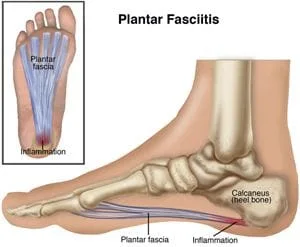We offer a variety of services to treat our valued patients suffering from foot, ankle, and heel pain. We encourage you to learn more about what we provide and how we can help. If you have any questions, please contact us by calling (954) 437-0200. We're always happy to hear from you!
PLANTAR FASCIITIS

Heel pain that is felt on the underside or bottom of the foot is often caused by an often-painful condition called Plantar Fasciitis.
Plantar Fasciitis, also called a heel spur, causes pain, irritation, and inflammation across the bottom of the foot. The plantar fascia, a ligament that runs from the heel of your foot to the ball, connects your heel bone to your toes. When this ligament becomes strained, it can result in chronic pain.
What Does Plantar Fasciitis Feel Like?
It’s one of the most common causes of foot discomfort, causing a sharp pain that feels like a pin or knife that’s been stuck in your heel when you wake up in the morning and begin walking. Although the pain will start to subside as you move around through the day, it can reappear if you stand for a long period of time, or when you stand up after sitting behind a desk for most of the day.
Who Is Most Susceptible to Plantar Fasciitis?
- Runners and other athletes
- Pregnant women
- People who are overweight and often stand and walk
- People who wear shoes that have little to no support
- People who are getting older
How Is Plantar Fasciitis Prevented and Treated?
- Stretching. Each morning, before taking your first steps of the day, sit with your feet in a 90 degree angle. Get a towel, belt, or rolled up pillowcase (anything that will help with reaching you your foot) and wrap it around your forefoot at the base of your toes. Gently pull your foot back towards your nose. This will help stretch the plantar fascia tendon and get it prepared to step down on the floor. After long periods of inactivity (30 minutes or more), the plantar fascia will need to be stretched again.
- Icing. Every evening, sit with your feet up for 10-15 minutes and apply an ice pack (a bag of frozen peas or carrots works great, too!) to the sore area. Ice is a great natural anti-inflammatory that will help to repair the inflammation in the plantar fascia tendon.
- Orthotics. Wear hard orthotics in your shoes will help support the plantar fascia tendon and protect it from further injury.
- Nonsteroidal anti-inflammatory drugs (NSAIDs). NSAIDs, such as ibuprofen or naproxen, may be taken with direction of a podiatrist or physician.
- Cortisone injections. Cortisone is an anti-inflammatory medication that is injected into the plantar fascia tendon to reduce inflammation and pain. Cortisone should only be administered by a trained podiatrist or physician.
- Extracorporeal Shockwave Therapy (ESWT). ESWT is a nonsurgical method that delivers high-energy acoustic (sound) waves to a targeted area in order to to treat various musculoskeletal conditions, including plantar fasciitis.
So, if you're suffering with heel pain, don't wait for it to become a chronic problem. Contact us today, and we'll get you back, to the activities you love, in no-time.
ANKLE SPRAINS
Sprains are common. You might sprain your ankle while participating in your favorite athletic activity, or while simply walking to work as you do every morning.
A sprain is the stretching or tearing of a ligament. A ligament is a fibrous band of connective tissue that joins the ends of two bones together. Ligaments stabilize and support the body's joints. Ligaments in the knee, for instance, connect the upper leg with the lower leg, allowing you to walk and run. Ankle sprains are common, and typically occur when the ankle rolls suddenly inward or outward.
Symptoms of a sprain include pain, bruising, swelling, and inflammation. The individual often feels a tear or pop in the joint. In severe cases, this may make the joint nonfunctional.
In other cases, where the sprain partially tears the ligament, some swelling may occur.
Prevention and Treatment
There is no way to make yourself immune to sprains, but proper stretching, appropriate footwear and warming up before engaging in physical activity will help alleviate these potential problems. Treatment regimens can vary depending on the severity of your injury, but one thing never changes--visiting your podiatrist as soon as possible can help prevent risk of complication or long term injury.
If you have suffered a sprain or strain, come in immediately and learn of all your treatment options"
FOOT AND ANKLE FRACTURES

Approximately 10% of all fractures occur in the 26 bones of the foot. These bones comprise of 2 bones in the hindfoot (calcaneus, talus), 5 bones in the midfoot (navicular, cuboid, 3 cuneiforms), and 19 bones in the forefoot (5 metatarsals, 14 phalanges). In addition, the foot contains sesamoid bones. Here at Podiatric Associates, we treat fractures of the foot and ankle. With analyzing x-rays taken on site, decision will be made for either conservative care in a boot or cast or to intervene surgically when justified.
With any trauma, please know that at Podiatric Associates, we offer same day appointments and on-site x-ray in order to diagnosis and appropriately treat a fracture of the foot and ankle as we are fully trained in conservative and elective surgeries of the foot and ankle.
TENDON INJURIES

Odds are that you’ve heard of Achilles tendonitis. Maybe a friend or relative contracted it, or one of your favorite athletes was taken out of the game by this painful condition. If you yourself have started to feel the telltale ache of Achilles tendonitis, you may be concerned about treatment, or fear a dramatic rupture of the tendon.
There’s no need to worry. The sooner you see a qualified podiatrist for diagnosis and treatment, the sooner you can start the healing process, and take precautions to prevent the worsening of your condition.
Symptoms
The Achilles tendon is the strongest and largest tendon in the body, connecting the leg to the foot as it stretches from the lower leg to the heel bone.This tendon is crucial to normal walking, as it allows the foot to rise up on the toes. If you are experiencing painful swelling in the back of your foot just above the heel, you may be suffering from Achilles tendonitis.
Achilles tendinitis is, at its most basic level, a strain of the Achilles tendon. The tendon naturally weakens with age, and strains are increasingly likely as you grow older, particularly if you suddenly increase the intensity of your workouts. Achilles tendonitis can also be caused by bone spurs and tight calf muscles.
How Do I Know I Have Achilles Tendonitis?
The sprain causes pain along the line of the Achilles tendon, particularly in the morning. The pain will also usually intensify after you run or participate in sports.
As Achilles tendonitis is best treated early in its development, speak with your trusted podiatrist if you are experiencing pain or swelling along the Achilles tendon. A consultation at our practice will give you the best chance possible for a full recovery.
POSTERIOR TIBIAL TENDON INJURY

Posterior tibial tendon dysfunction (PTTD) is the inflammation or overstretching of the posterior tibial tendon in the foot. The key function of the posterior tibial tendon is to support the arch in the foot. The tendon serves as a major supporting structure to assist the foot function while walking--however, if PTTD is present than the result is oftentimes an “adult-acquired flatfoot.”
Generally, adult-acquired flat-foot occurs only in one foot, but can be seen in both. This ailment is generally progressive, so if left untreated, the symptoms will continue to get worse. Symptoms generally occur after an activity that requires the use of the tendon such as running, walking, hiking or climbing stairs.
Symptoms of PTTD will change as the condition worsens, but initially include:
- Pain
- Swelling
- Flattening of the arch
- An inward roll of the ankle
When PTTD initially develops, it begins with a pain on the inside of the foot and ankle. The area may be red, warm, and swollen, as well. As the arch begins to flatten, there may still be pain on the inside of the foot and ankle, however, the foot and toes begin to turn outward and the ankle rolls inward. As it reaches its advanced stages, the arch continues to flatten and the pain often shifts to the outside of the foot, below the ankle. This indicates that the tendon has deteriorated considerably and arthritis is likely developing in the foot.
So, if you're suffering with these symptoms, come in and be evaluated and learn more about your treatment options. It is our goal to keep you moving.

ESWT, or Extracorporeal shockwave therapy treatment is an option for patients with chronic plantar fasciitis. By delivering a focused shockwave to your heel it induces a microtrauma on the tissue that’s affected your plantar fasciitis. Your body naturally responds with a healing response that causes your blood vessel to form and increase delivery of healing nutrients to the affected area, thereby relieving symptoms of plantar fasciitis shortly after stimulating this repair process. It’s effective and non-invasive and has a high success rate.
If you are living with chronic pain in your life, let us share this information of a state of the art solution to your problem.

